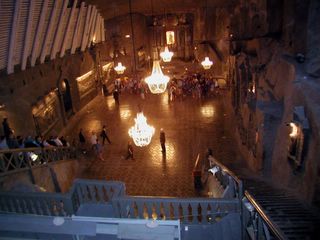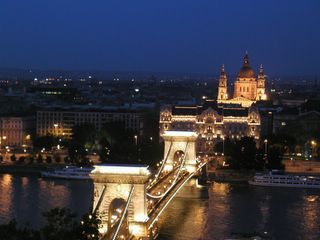Poland, 18-24 June
Krakow June 18-22
We arrived in Krakow on Saturday evening after a 9-hour train rides from Budapest. We enjoyed the ride. We had a cabin to ourselves with comfortable seats and climate control. We were able to rest our feet, read and see the countryside of 4 countries we were passing on the way: Hungary, Slovakia, Check Republic and finally Poland. Border guards with different uniforms boarded the train every couple of hours and politely asked for passports, (which they inspected casually) in a different language.
Krakow itself is a lively college town (25% of the population are students) with an impressive fortified Palace on a hill and a wonderful main square. The old market square had a wonderful feel both day and evening, with folk music, scores of cafes and restaurants with outside seating and colorful awnings, flower stands, book stores and more. It was teaming with locals and tourists all day long. The weather was wonderfully cool and breezy with puffy clouds floating in and out. The evenings were particularly lovely on the square, with peach and blue sunsets and flocks of little black birds (swifts?) flying high around the towers and pretty blue green steeples of the churches.
For me (Dahlia) the experience was more emotional than I expected. All of a sudden I was in a town I have never seen before, and yet I understood and even "sensed" the language very clearly. The street scenes, the signs and store fronts of the local commerce, bakeries, hair dressers, tailor shops, shoe stores etc. seemed like there were from a distant dream. Oddly, it somehow did not feel at all foreign, although I have never been here. I could hear my mother’s voice clearly speaking these words as she was telling me about her days and errands in Polish. All of a sudden I felt as if I have stepped into her shoes, flown to her old country, and was walking in them through a bit of her life. I could even inadvertently eaves drop on the conversations of passer's by on the street and they didn't sound foreign to me at all. I kept thinking how I wish my parents were still here and how they would react when I tell them what I saw and how it felt. They never expressed any desire to visit Poland again. I imagine the memories they left behind were too painful to revisit, but I can’t help but see a smile on their faces, maybe remembering the good days of their youth and happy that the Polish they spoke to me as a child helped us feel almost at home in Poland.
The visit to Aushwitz was difficult. We had a very articulate guide who gave us a feel of how the camps were operated. Seeing the efficiency and deliberateness of the Nazi extermination apparatus was horrifying and even with the evidence before our eyes, hard to conceive. In addition to the crematoria and models of the gas chambers were the awful barracks where prisoners were housed under completely in-human conditions in the freezing Polish winters. There were the barbed wire electrified fences and watch towers and one could see some examples of large containers with carefully segregated items looted from the millions of victims before they were taken to the gas chambers, so they can serve the needs of the Third Reich. They were huge bins of shoe (adults separated from children’s shoes), eye glasses, artificial limbs, Infants clothes, suitcases bearing the personal information of their former owners (who were lead to believe that they needed to bring along items that will help them resettle in Eastern Poland) , and bins of ladies hair which was sold by the kilo to be made into fabric later used by the Germans. It is of course hard to describe how these sights made us feel.
Aushwitz and Birkenow are now, and probably even then, are surrounded by lovely countryside and Polish villages, with many trees and green meadows. The contrast between the present and the past that lies below it is difficult to comprehend.
Warsaw June 22-24
A 3 hours train rides from Krakow brought us to Warsaw in the early afternoon, into a gigantic 4 level train station. After unpacking at the hotel we signed up for an evening city tour and decided to use the remaining couple of hours to see if we can find the street addresses where Dahlia’s parents families lived.
Since Warsaw was leveled to the ground during WW II we knew we would not find the actual houses and sometimes not even the actual streets but we were hoping to at least see and visit the physical location where the houses stood before. It turns out that the streets we were searching still partially exist but the numbering systems have changed completely. As we were puzzling over where the house could have been It started raining heavily, almost as even the sky was crying with our hearts and we had to abandon the search for the day and wait till after the next day appointment with the research person at the Jewish Historical center.
The City tour was lovely. We saw the Royal Palaces and some of the parks on their grounds that were really lovely after the rain stopped. We traveled by bus the royal route that the Kings traveled between their various Palaces. We saw "Embassy Row" lined with beautiful old Palaces and Official residences. This is almost the only part of town which was spared the German Bombing as it's Palaces were occupied by the Nazi officers who Occupied Warsaw.
The tour also took us through the area which used to be the old Warsaw ghetto and is now a residential neighborhood with many parks, Schools and several monuments to the Warsaw Ghetto uprising and to the Jews and Poles that were murdered by the Nazis.
We saw the Old city which although completely destroyed by the Germans, it was rebuilt as an exact replica of the old city after the war. It is a lovely, colorful town with quaint buildings, cobble-stoned streets, and a beautiful large market square and an impressive, recently rebuilt, royal palace which serves as a Museum. We had a fabulous dinner just outside the old town and returned to the hotel.
The next morning we went to the Jewish Historical Center and met with a team of two people whose jov it is to help people find information about their families who perished during the war. They were indeed a wonderful team who was doing their job with care and passion.
They were able to help us a bit immediately by somewhat confirming the addresses we had and providing us with the maps of the street plan before the war, which allowed us to at least find the geographical location of where Dahlia's family used to live. It is now a very pleasant tree lined area. It was hard to believe that these very same streets witnessed the insane suffering and the death and destruction of hundreds of thousands of the Warsaw Jews some of the most unimaginable suffering of the Jewish people went on for years.
At the Museum we saw a documentary film about the life in the Warsaw Ghetto. The images are unforgettable even though we have seen many like them over the years. Being here in Warsaw, walking these same streets, and seeing the images of what these streets witnessed a mere 60 years ago made it so much more real. I could now see just what my parents saw when they returned from Siberia after the war to find the city and their homes leveled to the ground, with only large piles of rubble where houses used to be. I could imagine and feel so deeply what it must have been like to realize that your family is no longer, and realize what horrible suffering they have endured. Finding no closure, and no grave to go to and cry on and lay some flowers.
But, I could also begin to imagine what my parents’ youth used to be like. What they saw when they went to the old town, the tramways the traveled on, the daily commerce on the big old avenues, the language on the streets, and the houses in the old Jewish part of town.


























